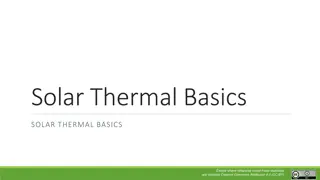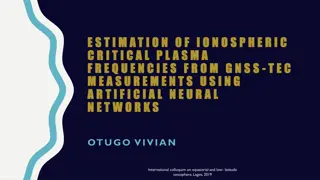Optimum Solar Proxy for Long-Term Ionospheric Studies
The search for the best solar proxy for long-term ionospheric studies is ongoing due to the lack of consistent solar radiation data. Various solar proxies have been analyzed, and the use of Mg II for foF2 and F10.7 for foE has shown promising results, describing a high percentage of variance in the data. Linear regression models indicate the effectiveness of these proxies in representing ionospheric trends over different time periods.
Download Presentation

Please find below an Image/Link to download the presentation.
The content on the website is provided AS IS for your information and personal use only. It may not be sold, licensed, or shared on other websites without obtaining consent from the author.If you encounter any issues during the download, it is possible that the publisher has removed the file from their server.
You are allowed to download the files provided on this website for personal or commercial use, subject to the condition that they are used lawfully. All files are the property of their respective owners.
The content on the website is provided AS IS for your information and personal use only. It may not be sold, licensed, or shared on other websites without obtaining consent from the author.
E N D
Presentation Transcript
What is the optimum solar proxy for long- term ionospheric studies? Jan Lastovicka Institute of Atmospheric Physics, Czech Acad. Sci., Prague, Czech Republic, jla@ufa.cas.cz For long-term studies as ionospheric trends investigations we have to use proxies of solar activity, because homogenous and sufficiently long data series of solar ionizing radiation are not available.
Introduction The problem of the best solar proxy for ionospheric and thermospheric investigations has been studied to some extent by various authors, e.g. Deminov et al. (2020), Dudok de Wit and Bruinsma (2017), Goncharenko et al. (2021), Gulyaeva et al. (2018), La tovi ka (2021), La tovi ka et al. (2006), Lean et al. (2011), Maruyama (2010), Mielich and Bremer (2013), Perna and Pezzopane (2016), Schm ller et al. (2021), Vaishnav et al. (2019). However, the problem of the best solar activity proxy has not yet been fully solved.
Data and Method The foF2 data of a north-south chain of European stations Juliusruh (54.6oN, 13.4oW), Pruhonice (49.98oN, 14.55 E) and Rome (41.8oN, 12.5oE) and foE of Juliusruh and Slough/Chilton (51.5oN, 1.3oW) are used for 1976-2014 yearly average values based on daily values on11-13 LT, for foF2 also monthly median values. Solar activity is characterized by six proxies: F10.7, F30, Mg II, He II indices, sunspot numbers and the H Lyman-alpha flux. The analyzed period 1976-2014 is divided into two sub-periods, 1976-1995 and 1996-2014 for foF2, because the dependence of foF2 on solar proxies differs in these sub-periods (La tovi ka, 2019). For this reason foE is analyzed over 1976- 1999 (in years close to 2014 there were also some data problems). Years 1989 and 1991 are excluded from foF2 analyses due to saturation of dependence of foF2 on solar activity (La tovi ka, 2019). A simple linear regression is used in all further analyses: Xion= A + B * solar proxy (1) where Xionis either foF2 or foE.
Usability of equation (1) Table 1. Percentage of total variance of foF2 described by equation (1) for yearly average values. I - 1976-1995, II - 1996-2019. Table 2. Percentage of the total variance of foE described by equation (1) for yearly values, 1976-1999. Values in brackets values without year 1991 (data problems). F10.7 Mg II F30 F10.7 F30 Roma I 0.98 0.98 0.98 Mg II foE Juliusruh II 0.99 1.00 0.99 99% 97% 97% Pruhonice I 0.98 0.98 0.98 (99%) (97%) (98%) II 0.99 1.00 0.99 foE Chilton 99% 97% 95% Juliusruh I 0.99 0.99 0.99 (99%) (97%) (98%) II 0.99 0.99 1.00 Tables 1 and 2 support Mg II for fof2 and F10.7 for foE as the best solar proxies, which describe 99% of the total variance of foF2 and foE. 99% means that equation (1) is fully usable, that the dependence of foF2 and foE on solar proxies is highly linear and that almost all variability of yearly values is described by solar proxies.
Results and Discussion foF2 foF2 Juliusruh foF2 Pruhonice foF2 Rome Table 3. Mean absolute differences (average calculated irrespective of sign) between observed and model (Eq. 1) values of foF2 in MHz. * - only 1979- 1995. F10.7 F30 Mg II F10.7 F30 Mg II F10.7 F30 Mg II Year 1976-1995 0.22 0.17 0.18* 0.22 0.17 0.19* 0.32 0.20 0.23* 0.22* 0.16* 0.22* 0.14* 0.37* 0.22* 1996-2014 0.14 0.11 0.12 0.15 0.11 0.09 0.17 0.12 0.10 January 1976-1995 0.36 0.28 0.30* 0.47 0.39 0.38* 0.42 0.36 0.39* 0.42* 0.28* 0.52* 0.43* 0.47* 0.38* 1996-2014 0.32 0.35 0.30 0.24 0.21 0.21 0.40 0.35 0.33 July 1976-1995 0.24 0.17 0.19* 0.31 0.26 0.22* 0.28 0.17 0.17* 0.23* 0.17* 0.30* 0.23* 0.27* 0.15* 1996-2014 0.22 0.21 0.16 0.31 0.24 0.22 0.35 0.25 0.20 Table 3 clearly shows that F10.7 performs slightly worse than F30 and Mg II. The performances of Mg II and F30 are best and in average equal.
Roma Pruhonice Juliusruh Table 4. Differences between observed and model (Eq. 1) yearly values for the last five solar cycle minima. The extreme minima of cycles 23/24 and 24/25 are separated in the bottom part. A negative difference means smaller observed than model value. F10.7 Mg II F30 F10.7 Mg II F30 F10.7 Mg II F30 1976 -0.19 0.11 0.07 0.27 -0.04 0.19 1977 -0.04 0.09 -0.13 0.19 0.10 0.18 1985 -0.20 -0.09 -0.06 -0.20 -0.17 -0.07 -0.12 0.04 0.04 1986 -0.24 0.01 0.09 -0.14 0 -0.01 -0.07 0.14 0.09 1995 -0.09 -0.18 -0.01 0.04 -0.06 0.06 -0.12 -0.16 -0.09 1996 -0.07 -0.02 0.11 0.11 0.11 0.18 -0.12 -0.04 0.13 2008 0.02 0.08 0.02 -0.20 -0.07 -0.18 -0.02 0.04 -0.04 2009 -0.27 -0.13 -0.32 -0.21 0 -0.23 0.02 0.01 -0.05 2018 -0.16 -0.14 -0.11 -0.22 -0.12 -0.15 -0.13 -0.11 -0.11 2019 -0.22 -0.22 -0.15 -0.22 -0.14 -0.12 -0.22 -0.21 -0.17 For the first three solar minima there is no systematic bias between model and observational foF2. The differences under the deep solar minima are smallest for Mg II but F30 is almost equal, whereas F10.7 performs less well.
Fig. 1. Differences between observed and model (Eq. 1) yearly values of foF2 for Pruhonice, 1996-2014. Green curve - solar activity proxy F10.7; blue curve solar proxy F30; red curve solar proxy Mg II; dashed black horizontal line no difference level. A negative difference means smaller observed than model value. Fig. 1 illustrates how important is the selection of solar activity proxy for long- term trends calculations. F10.7 (green curve) reveals a negative trend of foF2, Mg II (red curve) reveals a very weak negative trend of questionable reliability, and F30 (blue curve) provides essentially no trend. Thus trends calculated with different solar proxies might be different.
Results and Discussion foE F10.7 F30 Mg II Table 5. Mean absolute differences (average irrespective of sign) between observed and model (Eq. 1) values of foE in MHz, 1976-1999. * - only 1979-1995. Values in brackets without year 1991. foE Juliusruh 0.018 0.026 0.034 (0.018) (0.027) (0.029) foE Chilton 0.029 0.034 0.038 (0.026) (0.033) (0.029) Both Table 5 and Fig. 2 reveal F10.7 as the best solar proxy for foE. Trend of foE (if any) is weaker for F10.7 than for other proxies. Fig. 2. Differences between observed and model (Eq. 1) yearly values of foE for Juliusruh, 1976-1999. Green curve - F10.7; blue curve F30; red curve Mg II; brown curve He II; black horizontal line no difference level.
Conclusions 1. Out of six solar proxies used (Mg II, F30, F10.7, He II, sunspot number, H Lyman- flux), Mg II and F30 are essentially equally best, followed by F10.7, for the yearly average as well as monthly median values of foF2. Other three proxies perform less well (not shown here). 2. Out of six solar proxies used (Mg II, F10.7, F30, He II, sunspot number, H Lyman- flux), F10.7 appears to be best for yearly average values of foE followed by Mg II and F30. 3. The foF2 yearly average values in years of deep solar minima, 2008-09 and 2018-19 are reproduced best again by Mg II and F30. 4. The variance of yearly values of foF2 and foE is almost fully (99%) described by the best solar proxies and the relation is highly linear. 5. The trends with different solar proxies applied might be different. The best solar proxies tend to reveal weaker trends than the other solar proxies.
References Deminov, M.G., E.V. Nepomnyashchaya, V.N. Obridko (2020). Geomagn. Aeron., 60, 1-6, doi:10.1134/S0016793220010053. Dudok de Wit, T., S. Bruinsma (2017). J. Space Weather Space Clim., 7, A9. https://doi.org/10.1051/swsc/2017008. Goncharenko, L.P. et al. (2021). J. Geophys. Res. Space Phys., 126, e2020JA028446, https://doi.org/10.1029/2020JA028446. Gulyaeva, T.L., F. Arikan, U. Sezen, L.V. Poustovalova (2018). J. Atmos. Sol.-Terr. Phys., 172, 122-128, https://doi.org/10.1016/j.jastp.2018.03.025. La tovi ka, J. (2019). Geophys. Res. Lett., 46, 14208-14213, doi: 10.1029/2019GL085033. La tovi ka,J. (2021). Adv. Space Res., 67, 2-8, https://doi.org/10.1016/j.asr.2020.07.025. La tovi ka, J., A.V. Mikhailov, T. Ulich, J. Bremer, A.G. Elias, N. Ortiz de Adler, V. Jara, R. Abarca del Rio, A.J. Foppiano, E. Ovalle, A.D. Danilov (2006). J. Atmos. Sol.-Terr. Phys., 68, 1854-1870, doi: 10.1016/j.jastp.2006.02.009. Lean, J., J.T. Emmert, J.M. Picone, R.R. Meier (2011). J. Geophys. Res. Space Phys., 116, A00H04, doi:10.1029/2010JA016378. Mielich, J., J. Bremer (2013). Ann. Geophys., 31, 291-303, https://doi.org/10.5194/angeo-31-291- 2013. Perna, L., M. Pezzopane (2016). J. Atmos. Sol.-Terr. Phys., 148, 13-21, https://doi.org/10.1016/j.jastp.2016.08.003. Schm ller, E., J. Berdermann, M. Codrescu (2021). J. Geophys. Res. Space Phys., 126, e2020JA028861, https://doi.org/10.1029/2020JA028861. Vaishnav R., C. Jacobi, J. Bedermann (2019). Ann. Geophys., 37, 1141-1159, https://doi.org/10.5194/angeo-37-1141-2019.























